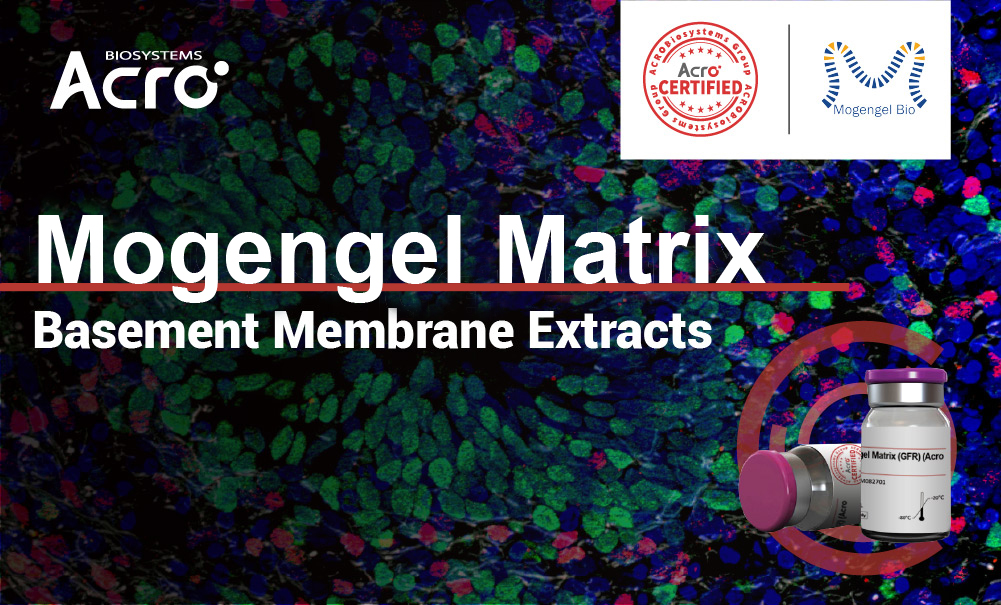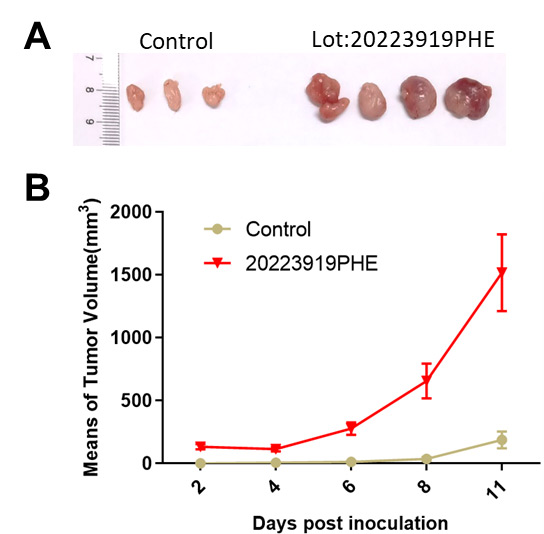> Insights > Mogengel Matrix – From Cell Culturing to Disease Modeling and Everything In-Between

>> Click here to learn more about Mogengel Matrix basement membrane extracts
Immunology is a rich, diverse field that involves a wide array of elements and perspectives. In many cases, research has heavily emphasized the details: discovering and elucidating signaling pathways that stimulate, suppress, or regulate immune cell function. In other cases, immunology focuses on a cellular-level perspective: immune cell interactions and responses. However, the primary end-goal of all of each of these research perspectives is to identify new targets for immunotherapy or novel therapeutic strategies to overcome an erratic immune system; otherwise considered a part of translational medicine. As immunology continues to uncover information collected in the molecular and cellular perspectives, scaling-up this information into the tissue / organ-level requires a more complex modeling system that is challenging to reproduce. At this stage, there are still many challenges, including how to form the optimal conditions to drive stem cell growth without differentiation and how can cells assemble into its correct structure?
Bridging the gap between each perspective are basement membranes, a complex composition of extracellular matrix proteins that provide cells with both structure and chemical signals to drive cellular growth and differentiation. Naturally, this membrane is ever-present – acting as a bridge or surrounding material to provide cellular structure to cells.
Basement membrane extracts are a natural or synthetic, randomly interwoven composition of extracellular matrix proteins that are layered in intricate sheets to provide a three-dimensional structure. Natural basement membrane extracts are derived from gene-edited mouse tumor cells, usually mouse sarcoma tumors, that are rich in extracellular matrix proteins. Further purification steps are also available to generate a ‘reduced growth factor’ extract which minimizes the chemical signals present within the matrix itself. Composed of laminin, fibronectin and various other proteins, the resulting structure forms a hydrogel that can be used in cell proliferation, differentiation, or even used to direct cell behavior, health, or growth dynamics. However, it must also be noted that basement membrane extracts are prone to lot-to-lot diversity and can be hard to work with. Tailoring the right concentration and protocol for any application is critical towards developing a successful model, alongside product quality and consistency.
Developing the right hydrogel using basement membrane extracts is challenging yet still crucial for successful culturing. Depending on the concentration or the integrity of the hydrogel formed, cell behavior can differ significantly. For 2D cell culture, whether it is for iPSCs or other primary cells, a thin layer coating works best. Promoting surface attachment and maintaining stem cell stemness is critical, thus using a reduced growth factor extract should be utilized to minimize differentiation influences from intrinsic cytokines or growth factors.
Stem cell differentiation, however, may require the addition of other stem cell growth factors. By mixing growth factors within the gel before plating stem cells, differentiation can be induced towards the targeted cell type.

Figure 1. Differentiation and expansion of (a) induced pluripotent stem cells (iPSCs) into (b) myocardial cell precursors after induction.
3D cell culturing, on the other hand, takes advantage of the gel-like properties of basement gel extracts to provide the cellular structure needed to form organ precursors, also known as organoids. Instead of being derived from a cell line, organoids are composed of various types of cells that match its starting material composition, providing an in vitro ‘snapshot’ of cell diversity and structure. This is extremely useful in immunology disease modeling, especially for research looking deeper into cell-tissue or more macro-level interactions. In most cases, when culturing organoids, tissue fragments are mostly used as a starting material. Depending on the desired organoid type, both thin layer and thick layer gels are sufficient to provide the optimal environment for 3-dimensional cellular growth. This includes mouse intestinal organoids, hepatobiliary organoids, and lung tracheal organoids.

Figure 2. Culturing of (a) mouse intestinal organoids, (b) mouse liver ductal organoids, and (c) mouse airway organoids in a 70% Mogengel Matrix GFR gel.
Certain organoids may be harder to culture, such as human tumor organoids. By mixing the starting material with the basement membrane extract before plating and gelling, improved organoid structure can be observed. A denser extracellular matrix layer and thicker gel layer provides a better scaffolding for cell attachment and growth. Similarly, organoid growth factors can be added to further help promote growth and accurate cell diversity.

Figure 3. Culturing of (a) colorectal cancer organoids, (b) gastric cancer organoids, and (c) breast cancer organoids, and (d)hepatocellular carcinoma organoids in a 70% Mogengel Matrix Organoid gel.
Whereas organoids provide a good cellular-level precursor model for immunology research, basement membrane extracts are also a critical component macro-scale disease modeling such as angiogenesis and patient-derived tumor xenografting. Certain modeling studies such as angiogenesis mimic the physiological extracellular matrix that can promote structure formation; in the case of angiogenesis, this is blood vessel formation. This is an especially critical model for tumor formation to make the connection between how structure formation (tissue-level) can be affected by cell signals (molecular-level) and identifying key targets to combat this effect.

Figure 4. Subcutaneous injection of Mogengel plug to assess angiogenic activity of different compounds mixed with VEGF, Heparin, or both; both of which are known angiogenesis-inducing factors. Intensity of red denotes the degree of blood vessel formation.
Patient-derived xenografting (PDX), on the other side, is one of the major precursors for personalized medicine through patient-specific diagnostics. Just like how each person has their own individual features, each tumor has their own specific markers and cell composition that can make it hard to treat. PDX takes a sample of the solid tumor and recreates the tumor in a mouse model. This is especially critical for treatment planning, where mice can be subjected to various treatments to identify the optimal treatment path and minimize relapse or refractory responses. A key component of PDX is the basement membrane, providing both structure and growth factors essential for tumor development.

Figure 5. (a) Control vs Mogengel-assisted tumor grown in vivo using a mouse model. (b) Tumor volume growth after tumor cell inoculation between control (only tumor cells) and Mogengel assisted growth.
The versatility of basement membrane results in a near-universal reagent that can be applied in various applications, including cell culturing, organoid culturing, and most importantly, disease modeling. However, choosing the right method is crucial. Various coating protocols will produce hydrogels with different properties such as tensile strength, permeability, and adhesivity. As such, this can significantly affect its performance regarding the desired application, especially with harder-to-culture cells, that have more specific requirements for cell growth. For a quick overview of the coating-type and desired application, please refer to Table 1.
Table 1. Coating methodologies and their applications.
| Coating Type | Description | Application |
| Thin Layer Coating | A thin layer of Mogengel Matrix is formed at the bottom of a well plate. |
|
| Thick Layer Coating | A thick layer of Mogengel Matrix is formed at the bottom of a well plate. |
|
| Sandwich Coating | Two thick layers of Mogengel Matrix are formed to surround the cultured cells. |
|
| Embedded Dome Coating | Cells are mixed with liquid-form Mogengel Matrix and plated in a dome-formation. |
|
Overall, basement membrane extracts are a versatile reagent that is critical to both basic and translational research. Starting from cell culturing and all the way to disease modeling, basement membranes are a critical component towards understanding and interpreting the interplay between molecules, cells, and tissue layers, especially in immunology and disease pathology. One thing to note is that most basement membrane extracts are derived from gene-edited mouse tumor cells. Using a more natural-like basement membrane extract in comparison to synthetic extracts in general gives better results. However, in comparison to synthetic derivatives, basement membrane extracts are prone to batch-to-batch diversity and can be hard to work with. Tailoring the right concentration and protocol for any application is always critical towards developing a successful model, as well as quality and consistency. At ACROBiosystems, we are currently partnering with Mogengel Bio through Acro Certify to bring you an application-validated basement membrane extract, Mogengel Matrix. For every batch manufactured, application studies are performed, such as organoid culture, stem cell culture, angiogenesis, tumor invasion, and tumor xenografts, to ensure that our products can support the optimal application requirements.
1. Arnaoutova, I., George, J., Kleinman, H. K. & Benton, G. Basement Membrane Matrix (BME) has Multiple Uses with Stem Cells. Stem Cell Rev. Reports 8, 163–169 (2012).
2. Benton, G., Kleinman, H. K., George, J. & Arnaoutova, I. Multiple uses of basement membrane-like matrix (BME/Matrigel) in vitro and in vivo with cancer cells. Int. J. Cancer 128, 1751–1757 (2011).
3. Aisenbrey, E. A. & Murphy, W. L. Synthetic alternatives to Matrigel. Nature Reviews Materials vol. 5 (2020).
4. Youn, J. & Kim, D. S. Engineering porous membranes mimicking in vivo basement membrane for organ-on-chips applications. Biomicrofluidics 16, 1–7 (2022).
5. Lopera Higuita, M., Shortreed, N. A., Dasari, S. & Griffiths, L. G. Basement Membrane of Tissue Engineered Extracellular Matrix Scaffolds Modulates Rapid Human Endothelial Cell Recellularization and Promote Quiescent Behavior After Monolayer Formation. Front. Bioeng. Biotechnol. 10, 1–15 (2022).
This web search service is supported by Google Inc.
